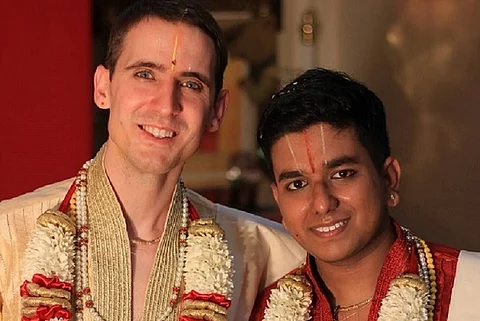

Why LGBTQ+ Series? Read here.
On a beautiful day in January, Salaphaty Rao and John McCane, both in their 20s, got engaged in a Vedic ceremony in Melbourne in the presence of family and friends.
It was the beginning of a fresh chapter in their nearly three-year-long inter-continental relationship between the two men. Salaphaty, a Malaysian Indian, moved to Australia for studies, whereas John is a resident of Ohio in the United States.
The duo, who share a common interest in Hinduism, met on a Facebook Group for LGBT Hindus and experienced an instant connect. They met in person for the first time in 2013 in India, and embarked on a cross-country trip during which they discovered their love for each other.

While Salaphaty's follows the Sri Vaishnava tradition, which he took on from his family, John was brought up as a Protestant Christian. It was during his visits to India that he got interested in Hindu philosophy and scriptures, which also brought the couple closer.
"I considered myself a Hindu and a Sri Vaishnav many years before I had even met Salaphaty. I feel that even if some of the modern culture has veered to the far right in recent years, Hinduism as a whole is very accepting in the absolute plurality of its faiths and philosophies," John told TNM over email.

Both Salaphaty and John are traditional Sri Vaishnavs and are trained in Sanskrit and Pancharatra Agama. So there was no doubt over the choice of ceremony they'd have for their engagement.
John also pointed out that the Vedic ceremony does not bind two people in matrimony based on their gender. In fact, it is the exact opposite, he explains.
"Something important for us is that in a traditional ceremony, the partners being wed or engaged are called only as jeevatma (the genderless soul) rather than male or female in the compulsory mantras recited," he said.

Despite their beliefs of inclusivity, getting a priest to perform the Vedic ceremony proved impossible for the two men. So, in an act of claiming his agency, Salaphaty performed the ceremony himself after learning the mantras.
"This is partially why, after we marry, we want to set up a temple and ashram that is all inclusive to foster education of Vedic and Puranic literature but also a place of shelter for those who have been the victims of prejudice. We want to make a place where, if people need a priest for LGBT services, they can come without the fear of repercussion,” explains John.

Unlike a lot of other same-sex couples, however, Salaphaty and John's relationship was not only accepted, but was also openly welcomed by their families.
"My parents were happy as they had known Salaphaty for about a year at that point and really liked him. As for his parents his mother had known me longer than his father but both readily accepted me into their family. I felt extremely welcome from day one," he said.

For someone who has lived in India for some time (he studied in Bengaluru), John feels that the country has a long way to go when it comes to its current laws regarding homosexuality.
He however adds that "the general populace of India seems to be progressive and liberal for the greater part. I have actually felt more welcomed in some settings in India being openly gay than in the US."
But doesn't he think that the warmth he experienced from people here is limited to a certain section, or say class, of people? In a country where it is still criminal to be gay, can his experiences be termed as rare then?
"Of course my experiences were shaded because I am a white foreigner, this is obvious," he conceded. "But then while traveling we have people, who you would not consider as upper class people, who didn’t seem the least bit bothered by our relationship. But of course I cannot comment on what someone else may experience," he asserted.

John also talks about the prevalence of caste system in India vis-a-vis his upper caste gay activism- a Vedic ceremony being rather Brahminical and one which reaffirms the discriminatory practices of ancient India.
He explains while caste has become about social hierarchy now, it was not always the case. "Caste was, at one time, a work system. You were the caste by the profession you took up and not based upon family or status."
"Essentially," John elaborated, "what I am trying to establish is an understanding into what the Varnashrama system actually meant and how it worked until relatively recently. Whenever I speak of caste or creed this is how both myself and fiancé see it. As something that was never meant to divide but sadly has become perverted by a few.”
He added that whatever the case may be, legislation should never be bound by caste. “We will not [want to] make gay marriage legal for only todays Brahmins or kshytrias, but for the entirety of all those across the length and breadth of India. Activism, regardless of where it begins must be kindled."

As for the D-Day, the couple plans to tie the knot anytime next year depending on Visa clearance. And regular visits to India are definitely on their to-do list. "We will probably return several times a year. After we marry, we plan to come to India to visit as many of the Divya Desha as we can. Our next big trip that has already been planned to Kanchi in 2019 to see the Athi Varadar raised," says John.
(Monalisa Das also contributed to this story)
Are sex and gender the same? Or are they different? Confused? Read our explainer here.
There's a lot more to LGBTQ+ than the rainbow filter in your profile picture. Read our exhaustive explainer here.
